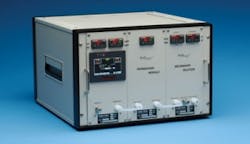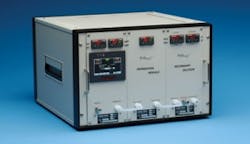This firm's K-System, H-System, and Z-Series intrinsically safe solutions have received Bureau Veritas, Germanischer Lloyd, Lloyds Register, and Det Norske Veritas approvals for use in marine-type operations.
K-System intrinsic safety barriers are a range of products designed for discrete or analog signals. These barriers connect easily with the exclusive PowerRail system. By using PowerRail, a group of safety barriers is energized from an AC or DC source and monitored for group fault conditions.
H-System intrinsic safety barriers are backplane mounted isolated barriers.
Z-Series zener diode barriers are a hardware method for solving hazardous area barrier and intrinsic safety applications. The company's zener diode barriers feature an encapsulated housing, are suited for DIN rail mounting, and are fit for AC and DC applications.
Source: Pepperl+Fuchs Inc., 1600 Enterprise Parkway, Twinsburg, OH 44087.
New interactive tool for instrumentation designThe instrumentation business value calculator (BVC) is a new interactive tool that calculates the savings that can be achieved by engineering companies by adopting the latest instrumentation technology.
The BVC assists with estimating the time and cost savings a business could achieve by implementing this firm's life cycle solution for designing, installing, and maintaining instrumentation in plants and offshore vessels.
The company says the BVC demonstrates the savings that are achievable in a project. Using parameters such as head count, hourly costs, and input/outputs that users can input themselves, the tool calculates savings in man-hours and money across a number of deliverables.
The tool highlights benefits such as more productivity through catalogs and rule-based automation, and better project quality through right first time design and automatic, accurate materials and production information.
Source: AVEVA Solutions Ltd., High Cross, Madingley Rd., Cambridge, CB3 0HB, UK.
New gas standards generatorThe new FlexStream automated permeation tube system combined with secondary dilution module SD creates variable concentration gas mixtures in constant output flow.
The developer says many contamination exposure applications require a constant and often rather large flow of the test gas mixture. This system simplifies production and reduces the cost of supplying the required test gas mixtures, the firm notes.
When using permeation tubes, mixture concentration is typically adjusted by varying dilution flow. Changing from 1 ppm to 100 ppb, for example, might require changing dilution flow from 500 cc/min to 5 l./min. This creates no problem so long as the dilution flow exceeds the minimum flow required for the application. But for applications with high minimum flow, the flow required to create even a 10X concentration reduction can be impractically large, the company points out.
In the FlexStream/SD system, primary mixture concentration can be varied over a 10:1 range in the permeation unit. An adjustable aliquot of that mixture is added to a constant dilution flow in the SD module. The resulting concentration adjustability is more than 100:1.
Source: KIN-TEK Laboratories Inc., 504 Laurel, La Marque, TX 77568.
More Oil & Gas Journal Current Issue Articles
More Oil & Gas Journal Archives Issue Articles
View Oil and Gas Articles on PennEnergy.com

